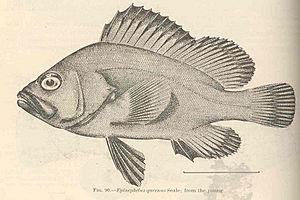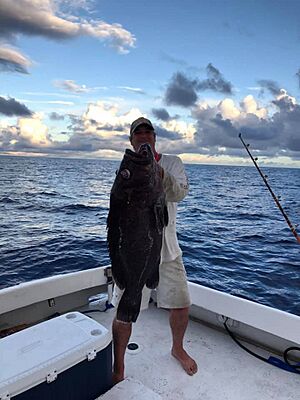Hawaiian grouper facts for kids
Quick facts for kids Hawaiian grouper |
|
|---|---|
 |
|
| Conservation status | |
| Scientific classification | |
| Synonyms | |
|
Epinephelus quernus Seale, 1901 |
The Hawaiian grouper (Hyporthodus quernus) is a cool type of fish found only in Hawaii. People also call it the Hawaiian black grouper, Seale's grouper, or Hapuʻupuʻu. It's a kind of grouper, which belongs to a larger fish family called Serranidae. This family also includes fish like anthias and sea basses. The Hawaiian grouper lives only around the Hawaiian Islands.
Contents
About the Hawaiian Grouper's Name
Scientists give every living thing a special name. The Hawaiian grouper was first described in 1901. An American fish expert named Alvin Seale gave it the scientific name Epinephelus quernus. Later, scientists decided it fit better into a different group, so its name changed to Hyporthodus quernus. The word quernus means "oaken." This might be because adult fish sometimes have a reddish color, like oak wood.
What Does the Hawaiian Grouper Look Like?
The Hawaiian grouper has a body that is about 2.3 to 2.7 times longer than it is deep. It has a special fin on its back called the dorsal fin. This fin has 11 stiff spines and 14 to 15 soft rays. Its bottom fin, the anal fin, has 3 spines and 9 soft rays. The tail fin is rounded.
Adult Hawaiian groupers are usually dark brown. They have faint white spots arranged in eight vertical lines. These spots can be hard to see because of many other pale spots and blotches. The fins are mostly plain, matching the body color. Some adults might have a slight blue tint on their belly. Others can have a reddish tint, which might help them hide from predators.
Younger groupers have more varied colors. They can be pale grayish. Their pale spots are also much clearer and easier to see. The biggest Hawaiian grouper ever recorded was about 122 centimeters (4 feet) long. It could weigh up to 22.7 kilograms (50 pounds). The largest one ever caught weighed 31.75 kilograms (70 pounds)!
Where Does the Hawaiian Grouper Live?
The Hawaiian grouper lives only in the waters around Hawaii. This includes the main Hawaiian Islands. It also lives in the Northwestern Hawaiian Islands. You can also find it near the Johnston Atoll.
Hawaiian Grouper Habitat and Life Cycle
The Hawaiian grouper is a demersal fish. This means it lives near the bottom of the ocean. You can find it on coral reefs and rocky areas. It lives at depths from about 20 meters (65 feet) down to 380 meters (1,247 feet).
This fish has an interesting way of reproducing. It is a protogynous hermaphrodite. This means it starts its life as a female. Then, later in life, it can change into a male. About half of the female groupers are ready to lay eggs when they are around 58 centimeters (23 inches) long. This usually happens when they are about 6 years old.
About half of the females change into males when they reach about 89.5 centimeters (35 inches) long. This change can happen earlier for some fish. The Hawaiian grouper usually lays its eggs between February and June. The busiest time for spawning is in March.
The Hawaiian grouper is a predator. It likes to eat other fish. Its second favorite food is crustaceans, especially shrimp.
Why Is the Hawaiian Grouper Important?
The Hawaiian grouper is a very important fish in Hawaii. Its meat is white and has a delicate flavor. People really value it for eating. It is part of a special group of fish called the "Deep 7." These are fish that live deep in the ocean near the bottom.
The "Deep 7" fish are a big part of Hawaii's fishing industry. They make up about half of all the fish caught by commercial fishermen in the state. This shows how important the Hawaiian grouper is to the local economy and food supply.



